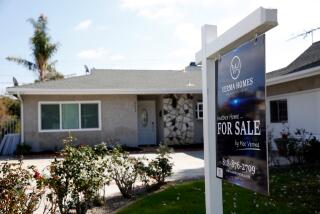Q&A: What’s keeping the housing market from reaching its full potential?
What if they threw a housing recovery and nobody showed up?
That thesis is not exactly accurate: Millions of people will have purchased homes this year, perhaps not at breakneck speed, but they are buying. According to the National Assn. of Realtors, existing home sales jumped 2.4% in October to a seasonally adjusted annual rate of 5.17 million.
Sales are now at their highest pace of 2014 but still remain 1.7% below the 5.26-million-unit level from September a year ago.
NAR maintains that the recovery won’t reach its full potential until more builders get with the program. That’s not to say builders aren’t producing new houses; they are, but not at the number that’s needed to satisfy latent demand.
According to the National Assn. of Home Builders, the nation’s hammer-and-saw folks will erect some 990,000 new dwellings this year. That would be up from 930,000 last year. But it would be a far cry from the 1.4 million or more that are necessary to satisfy folks looking for a brand-new residence.
“In a normal year, there should be demand for 1.7 million units,” Mark Zandi, chief economist at Moody’s Analytics, said recently at NAHB’s semiannual construction forecast conference.
Of course, the economy isn’t normal, at least not yet. So the “usual” number of people aren’t visiting model homes and signing contracts. Particularly absent are the 3 million to 4 million 18- to 34-year-olds who have yet to form their own households. They are living either with roommates or in Mom and Dad’s basement.
Zillow reports that 32% of all adults are now living with someone, up from 25% as recently as 2000. Stagnant wages have been a major contributing factor. On average, Zillow found that doubled-up adults earn about 76% of the median income of people living on their own.
The share of first-time buyers continues to underperform historically. First-timers, according to NAR, have represented less than 30% of all buyers in 17 of the last 18 months. That’s the lowest level in nearly three decades. Forty percent is the long-term average.
The share of entry-level buyers has been “well below normal” for the last seven years, according to NAR’s chief economist, Lawrence Yun, who says builders need to raise their production by 500,000 units “just to open up” the inventory of homes for sale.
“One of the constraining factors is inventory,” Yun explains. “First-time buyers tend to buy existing homes that owners vacate when they buy new homes. So builders need to build more so the natural chain reaction can begin. If we had more homes to sell, we’d make more sales.”
But builders are an optimistic lot. Setting the 2000-03 period as a benchmark for normal housing activity, when single-family production averaged 1.3 million units annually, NAHB economists expect single-family starts to rise steadily, from 48% of what is considered a typical market in the third quarter of 2014 to 90% of normal by the fourth quarter of 2016.
Put another way, the number of single-family houses built this year will hit 637,000 units, then increase 26% next year to 802,000 units, and reach 1.1 million houses in 2016.
That would be still short of “normal” demand, but who’s pushing it? Certainly not most builders, who were burned — many into oblivion — when the economy went south and they were stuck with too many unsold units.
“Single-family builders are feeling good,” said NAHB Chief Economist David Crowe. “They are not overly confident, but confident enough to keep moving forward.”
Realtors, on the other hand, aren’t feeling so good. Even as the use of lockboxes hits a 12-month high, the confidence of NAR’s members is at a 12-month low, Yun reported recently.
Yun said he can’t decide what’s more important: lockboxes or member sentiment. But in a few years, he added, the answer should be moot because a full recovery will have taken place and the housing market should once again be running on all cylinders.
For now, there are 2.3 million existing houses on the market, which is 6% more than a year earlier, when 2.17 million units had “For Sale” signs in front of them. But it’s not enough.
“The rise in doubled-up households is a troubling sign of the times and starkly illustrates one of the prime drivers behind weak sales,” said Zillow Chief Economist Stan Humphries.
If there is a silver lining to all this, it’s that all of those roommate households “represent tremendous energy for the market,” said Humphries, who figures half a million buyers are waiting in the wings to step into the market as the economy trudges forward.
Distributed by Universal Uclick for United Feature Syndicate.






